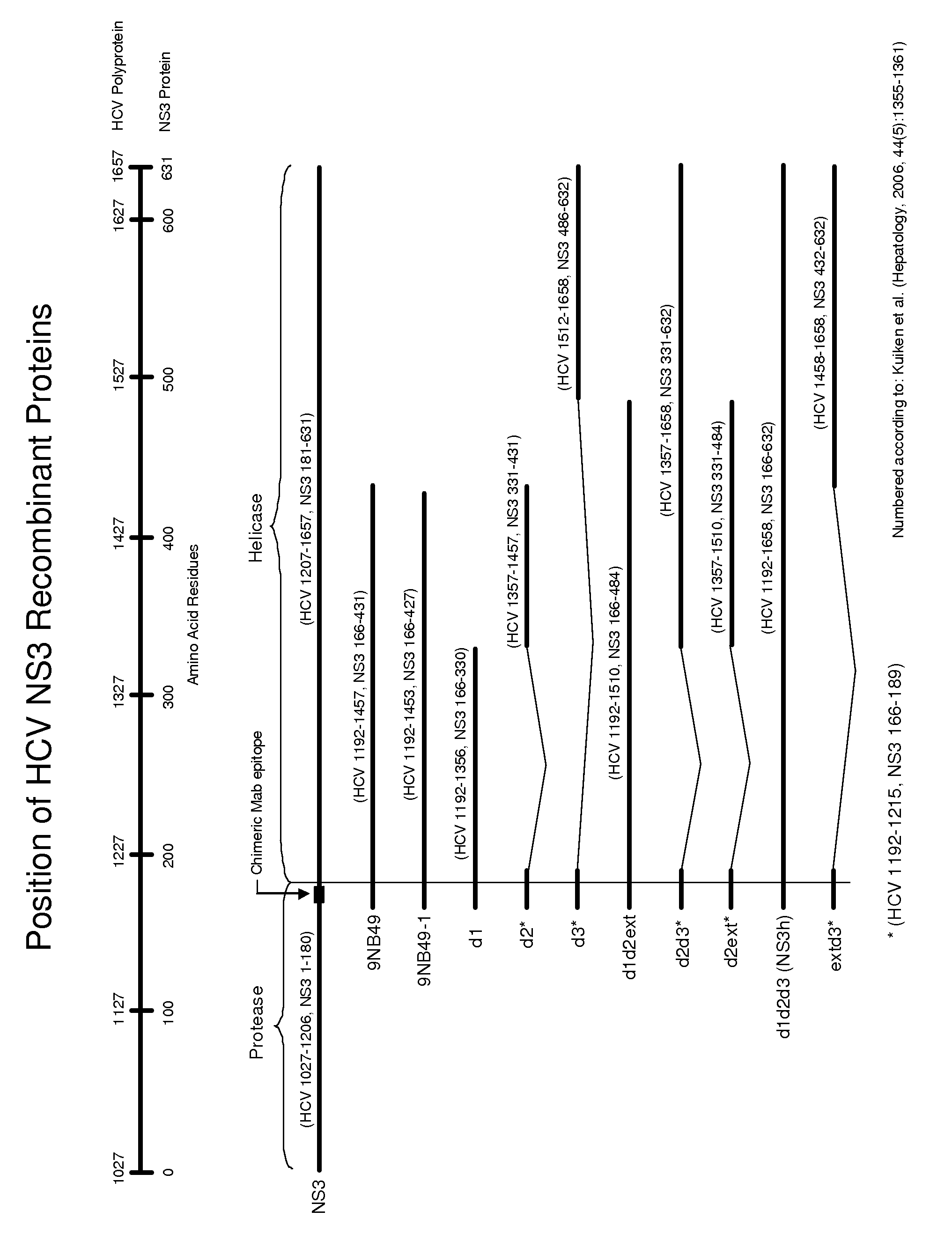HCV antigen-antibody combination assay and methods and compositions for use therein
a technology of hcv and antigen, which is applied in the field of immunoassays for detection and diagnosis of hcv infection, can solve the problems of inability to detect core antigen assays, inability to treat in all cases, and lack of vaccines
- Summary
- Abstract
- Description
- Claims
- Application Information
AI Technical Summary
Benefits of technology
Problems solved by technology
Method used
Image
Examples
example 1
Cloning and Expression of HCV NS3 9NB49H
[0213]The nucleotide sequence (Seq ID # 1) encoding amino acids 1192-1457 of HCV-1(Seq ID #) 2) was codon optimized for E. coli expression and cloned into a modified pET32a vector wherein the sequence encoding a thioredoxin fusion protein was eliminated, and replaced with Methionine (M). In addition, a carboxy-terminal hexahistidine tag (SEQ ID NO: 90) was included to facilitate purification via immobilized metal affinity chromatography (IMAC). E. coli BL21(DE3) cells were transformed with purified plasmid DNA and transformants screened. The resulting plasmid was designated p9NB49H and the protein expressed therefrom was designated as 9NB49H.
[0214]Protein expression was achieved by culturing the p9NB49H-transformed E. coli BL21(DE3) cells in terrific broth (TB) medium. Cells were grown in shake flasks to an OD600 nm of 0.50 and then induced with 1 mM IPTG and grown at 25-37° C. for approximately three hours until an OD600 nm of approximately ...
example 2
Cloning and Expression of HCV NS3 Nbt-9NB49H
[0215]The nucleotide sequence encoding the NS3 9NB49H protein described in Example 1 was subcloned into a modified pET32a plasmid wherein the open reading frame encodes an amino-terminal biotinylation tag (MSGLNDIFEAQKIEWHE) (SEQ ID NO: 91) with a GSGSNSM-linker (SEQ ID NO: 92) sequence upstream of the NS3-encoding sequence followed by a carboxyl-terminal hexahistidine tag (SEQ ID NO: 90) followed by a stop codon. The resulting plasmid was designated pNbt-9NB49H. The biotinylation tag, described by Beckett et al. (Protein Science, 8(4):921-929, 1999) permits site-specific biotin incorporation via a biotin ligase enzyme encoded by the E. coli BirA gene. E. coli BL21(DE3) cells were co-transformed with the pNbt-9NB49H expression plasmid and a second plasmid (pBirAcm) expressing the biotin ligase under control of an IPTG inducible promoter. Cells were grown in shake flasks at 37° C. in Terrific Broth with biotin added to 0.050 mM final concen...
example 3
Cloning and Expression of HCV NS3 9NB49H-Cbt
[0216]The nucleotide sequence encoding the NS3 9NB49H protein described in Example 1, was subcloned into a modified pET32a vector wherein the open reading frame encodes N-terminal methionine followed by NS3 followed by a GSGSG-linker (SEQ ID NO: 93) and a hexahistidine tag (SEQ ID NO: 90) followed by a GG-linker and the biotinylation tag (GLNDIFEAQKIEWHE) (SEQ ID NO: 94) and finally the stop codon. The resulting plasmid was designated p9NB49H-Cbt. Protein expression and biotinylation was performed as described in Examples 1 and 2.
PUM
 Login to View More
Login to View More Abstract
Description
Claims
Application Information
 Login to View More
Login to View More - R&D
- Intellectual Property
- Life Sciences
- Materials
- Tech Scout
- Unparalleled Data Quality
- Higher Quality Content
- 60% Fewer Hallucinations
Browse by: Latest US Patents, China's latest patents, Technical Efficacy Thesaurus, Application Domain, Technology Topic, Popular Technical Reports.
© 2025 PatSnap. All rights reserved.Legal|Privacy policy|Modern Slavery Act Transparency Statement|Sitemap|About US| Contact US: help@patsnap.com



